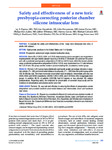Safety and effectiveness of a new toric presbyopia-correcting posterior chamber silicone intraocular lens
| dc.contributor.author | Pepose, JS | |
| dc.contributor.author | Hayashida, J | |
| dc.contributor.author | Hovanesian, J | |
| dc.contributor.author | Davies, J | |
| dc.contributor.author | Labor, PK | |
| dc.contributor.author | Whitman, J | |
| dc.contributor.author | Carter, H | |
| dc.contributor.author | Colvard, M | |
| dc.contributor.author | Buckhurst, P | |
| dc.contributor.author | Khodai, O | |
| dc.contributor.author | Mittleman, D | |
| dc.contributor.author | Feinerman, G | |
| dc.date.accessioned | 2017-05-04T12:10:11Z | |
| dc.date.available | 2017-05-04T12:10:11Z | |
| dc.date.issued | 2015-02 | |
| dc.identifier.issn | 0886-3350 | |
| dc.identifier.issn | 1873-4502 | |
| dc.identifier.uri | http://hdl.handle.net/10026.1/9187 | |
| dc.description.abstract |
PURPOSE: To evaluate the safety and effectiveness of the Trulign toric intraocular lens (IOL) in adults with cataract. SETTING: Eight private practices in the United States and 1 in Canada. DESIGN: Prospective randomized single-masked multicenter study. METHODS: A toric IOL (1.25 D, 2.00 D, or 2.75 D, determined by a toric calculator) was implanted in eligible patients with age-related cataract requiring a 16.00 to 27.00 diopter (D) spherical IOL power and with a predicted postoperative astigmatism of 0.83 to 2.50 D. Eyes within the lowest cylinder range (predicted postoperative astigmatism 0.83 to 1.32 D) were randomized in a 1:1 ratio between the 1.25 D toric IOL group and the nontoric accommodating IOL (Crystalens) control group. RESULTS: The toric 1.25 D group had a statistically significantly greater percentage reduction in absolute cylinder (P < .001) and uncorrected distance visual acuity (P = .002) than the control group at the 120- to 180-day visit. The mean monocular uncorrected vision at distance, intermediate, and near was 20/25, 20/22, and 20/39, respectively, with the 1.25 D, 2.00 D, and 2.75 D toric IOLs in aggregate (toric group). In addition, 96.1% of patients (123/128) had 5.0 degrees or less absolute IOL rotation postoperatively. Regarding safety, the endpoints for preservation of corrected visual acuity and the incidence of complications and adverse events were met. CONCLUSION: The toric IOL was safe and effective in reducing the effects of preoperative corneal astigmatism and provided excellent uncorrected distance and intermediate vision and functional near vision. FINANCIAL DISCLOSURES: Dr. Pepose is a consultant to Bausch & Lomb and was medical monitor of this study. Drs. Buckhurst, Whitman, Feinerman, Hovanesian, Davies, Labor, and Carter are consultants to Bausch & Lomb. At the time of the study, Drs. Hayashida, and Khodai were employees of Bausch & Lomb. Drs. Colvard and Mittleman have financial or proprietary interest in any material or method mentioned. | |
| dc.format.extent | 295-305 | |
| dc.format.medium | ||
| dc.language | en | |
| dc.language.iso | eng | |
| dc.publisher | Ovid Technologies (Wolters Kluwer Health) | |
| dc.subject | Aged | |
| dc.subject | Aged, 80 and over | |
| dc.subject | Astigmatism | |
| dc.subject | Biocompatible Materials | |
| dc.subject | Cataract | |
| dc.subject | Equipment Safety | |
| dc.subject | Female | |
| dc.subject | Humans | |
| dc.subject | Lens Implantation, Intraocular | |
| dc.subject | Lenses, Intraocular | |
| dc.subject | Male | |
| dc.subject | Middle Aged | |
| dc.subject | Phacoemulsification | |
| dc.subject | Presbyopia | |
| dc.subject | Prospective Studies | |
| dc.subject | Prosthesis Design | |
| dc.subject | Refraction, Ocular | |
| dc.subject | Silicone Elastomers | |
| dc.subject | Single-Blind Method | |
| dc.subject | Treatment Outcome | |
| dc.subject | Visual Acuity | |
| dc.title | Safety and effectiveness of a new toric presbyopia-correcting posterior chamber silicone intraocular lens | |
| dc.type | journal-article | |
| dc.type | Journal Article | |
| dc.type | Multicenter Study | |
| dc.type | Randomized Controlled Trial | |
| dc.type | Research Support, Non-U.S. Gov't | |
| plymouth.author-url | https://www.webofscience.com/api/gateway?GWVersion=2&SrcApp=PARTNER_APP&SrcAuth=LinksAMR&KeyUT=WOS:000350329700008&DestLinkType=FullRecord&DestApp=ALL_WOS&UsrCustomerID=11bb513d99f797142bcfeffcc58ea008 | |
| plymouth.issue | 2 | |
| plymouth.volume | 41 | |
| plymouth.publication-status | Published | |
| plymouth.journal | Journal of Cataract and Refractive Surgery | |
| dc.identifier.doi | 10.1016/j.jcrs.2014.05.043 | |
| plymouth.organisational-group | /Plymouth | |
| plymouth.organisational-group | /Plymouth/Admin Group - REF | |
| plymouth.organisational-group | /Plymouth/Admin Group - REF/REF Admin Group - FoH | |
| plymouth.organisational-group | /Plymouth/Faculty of Health | |
| plymouth.organisational-group | /Plymouth/Faculty of Health/School of Health Professions | |
| plymouth.organisational-group | /Plymouth/REF 2021 Researchers by UoA | |
| plymouth.organisational-group | /Plymouth/REF 2021 Researchers by UoA/UoA03 Allied Health Professions, Dentistry, Nursing and Pharmacy | |
| plymouth.organisational-group | /Plymouth/Research Groups | |
| plymouth.organisational-group | /Plymouth/Research Groups/Institute of Health and Community | |
| plymouth.organisational-group | /Plymouth/Users by role | |
| plymouth.organisational-group | /Plymouth/Users by role/Academics | |
| dc.publisher.place | United States | |
| dcterms.dateAccepted | 2014-05-19 | |
| dc.identifier.eissn | 1873-4502 | |
| dc.rights.embargoperiod | Not known | |
| rioxxterms.versionofrecord | 10.1016/j.jcrs.2014.05.043 | |
| rioxxterms.licenseref.uri | http://www.rioxx.net/licenses/all-rights-reserved | |
| rioxxterms.licenseref.startdate | 2015-02 | |
| rioxxterms.type | Journal Article/Review |


